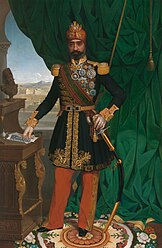
Hussein ibn Ali al-Hashimi was an Arab leader from the Banu Hashim clan who was the Sharif and Emir of Mecca from 1908 and, after proclaiming the Arab Revolt against the Ottoman Empire, King of the Hejaz from 1916 to 1924. At the end of his reign he also briefly laid claim to the office of Caliph. He was said to be a 37th-generation direct descendant of Muhammad as he belongs to the Hashemite family.

Muhammad III as-Sadiq GCB was the Husainid Bey of Tunis from 1859 until his death. Invested as Bey al-Mahalla on 10 June 1855, he succeeded his brother Muhammad II ibn al-Husayn on 23 September 1859. Named as divisional General in the Imperial Ottoman Army on 10 June 1855, he was promoted to the rank of Marshal on 10 December 1859.
This is a List of rulers of Sintang in Kalimantan, Indonesia.
The Huraa Dynasty was the sixth royal dynasty to rule over the Sultanate of Maldives from 1757 to 1965. It was founded by Sultan al-Ghazi Hasan 'Izz ud-din.
Husain Bey Gouta, Crown Prince of Tunisia was the titular head of the Husainid Dynasty. He was the third son of Muhammad V al-Nasir, Bey of Tunis, by his second wife, Lalla Husn ul-Ujud, from 1906 until 1922.

The Husainid dynasty was a ruling dynasty of the Beylik of Tunis, which was of Cretan Turkish origin. It came to power under al-Husayn I ibn Ali in 1705, succeeding the Muradid dynasty. After taking power, the Husainids ruled as Beys. Its succession to the throne was determined by agnatic seniority with the oldest member of the dynasty becoming Bey. The heir apparent to the Bey held the title Bey al-Mahalla. The Husainids originally ruled under the sovereignty of the Ottoman Empire. In 1881, with the Treaty of Bardo, Tunisia came under the control of France as a protectorate. Following independence from France on 20 March 1956, the Bey Muhammad VIII al-Amin assumed the title of King and reigned as such until the Prime Minister Habib Bourguiba deposed the dynasty and declared Tunisia a republic on 25 July 1957.
Abu l-Hasan Ali I, also known as Ali Pasha and Ali Bey I,) was the second leader of the Husainid Dynasty and the ruler of Tunisia from 1735 to 1756.
Kamal ad-Din is a male Muslim given name or surname, meaning "perfection of the religion" in Arabic.

Ahmad ibn Abi Diyaf, known colloquially as Bin Diyaf, was the author of a chronicle of Tunisian history; he was also a long-time and trusted official in the Beylical government of Tunisia. His multi-volume history, while it begins with the 7th-century arrival of the Arabs, devotes the most attention to details of the Husainid dynasty (1705–1957), during the 18th and 19th centuries. His writing is informed by his experience as chancellery secretary during the reigns of five Beys in succession. Bin Diyaf himself eventually favored the reform view, which was current then in Tunisian politics. His letter in reply to questions about Tunisian women has also attracted interest.

Shivakiar Ibrahim was an Egyptian princess and a member of the Muhammad Ali Dynasty. She was the first wife of King Fuad.

Ayn-al-Hayat Rifa'at was an Egyptian princess and a member of the Muhammad Ali Dynasty. She was the first wife of Sultan Hussein Kamel of Egypt.
Abu Muhammad Rashid al-Shakir Sahib al-Taba'a, born around 1790 and died 11 September 1837 at Le Bardo, was a Tunisian politician of Circassian origin.
Under the Muhammad Ali dynasty, the line of succession to the former Egyptian throne was subject to a number of changes during its history. From its founding in 1805 until 1866, the dynasty followed the imperial Ottoman practice of agnatic seniority, whereby the eldest male in any generation would succeed to the throne. In 1866, however, the then Khedive of Egypt Isma'il Pasha obtained a firman from the Ottoman Emperor which restricted the succession to the male-line descendants of Isma'il Pasha. The resulting succession remained in force until the abolition of the Egyptian monarchy in 1953, following the 1952 Egyptian Revolution.





